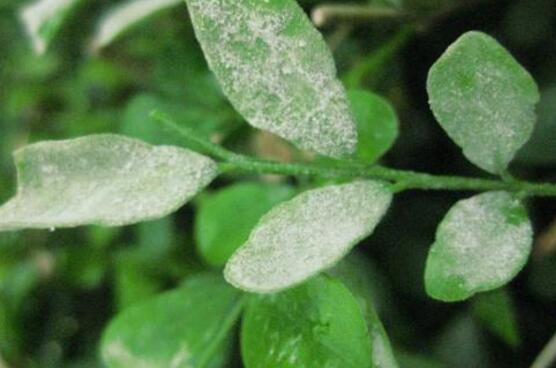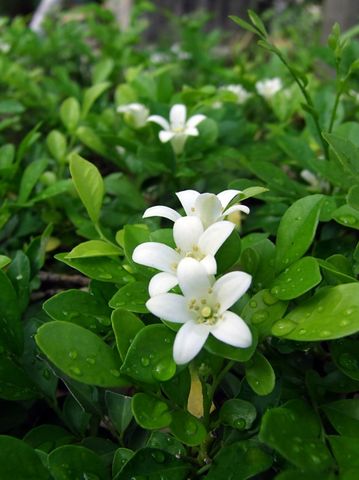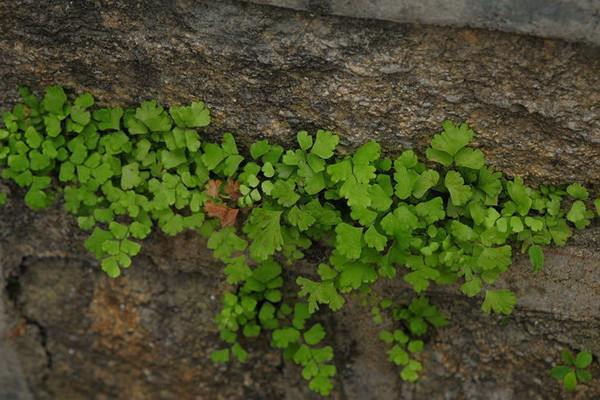Control methods of Jiuli incense leaf blight
[symptoms] occur on the leaves, mostly from the leaf tip leaf edge to start the disease, serious can also spread to the tip, tender stem. The disease spot begins as a faded green macula, expands rapidly, and soon infects the whole leaf and becomes yellowish brown. In the later stage, the leaves were withered and covered with black granules, that is, the conidia of pathogens.
[pathogens and occurrence characteristics] half-known fungi belong to the genus macrocaulis. The pathogen lives on the diseased remains of the host plant. The disease often infects frozen and burned plants, and then occurs seriously under high temperature and dry conditions, often resulting in a large number of deaths.
[prevention and treatment] ① should strengthen maintenance and pay attention to cold prevention. ② sprays 0.3% Bordeaux solution every 7 to 10 days in early spring. At the initial stage of the onset of ③, 70% topiramate was sprayed with 1500 times or 50% acetaminophen 1000 times.
What should we do when insects grow in Jiuli incense? disease and pest control of Jiuli incense / 3 insects and 3 diseases are sprayed with medicine
Jiuli incense, a very ornamental plant, is very popular with flower friends because of its frequent flowering period and charming scenery when it blossoms. In life, many flower friends keep Jiuli incense, but because of careless maintenance and other reasons, will attract diseases and insect pests, that Jiuli incense leaves worms how to do? The following is the pest control of Jiuli incense. If you love flowers, you must have a look.
One, nine incense leaves grow worms, spray with medicine

As a good product of indoor farming, many people keep Jiuli incense at home, but if they do not raise it according to the breeding method of Jiuli incense, it will grow worms and get sick. Flower friends must be very worried! As for what to do about the worms in Jiuli incense, we should determine which kind of bugs it is, and then solve the problem. In the prevention and control of diseases and insect pests of Jiuli incense, the editor talks about pests and diseases respectively.
(1) diseases and insect pests of Jiuli incense, 3 insect pests
Red spider, light shield green longicorn beetle, sagittal shield scale
1. Red spider
This insect is one of the main pests of Jiuli incense. It harms the leaves of the plant and survives by sucking on the leaf juice of Jiuli incense. Symptoms of damage: the plant will become malnourished, and the yellowing of incense leaves will appear.
Solution: if there are few red spiders, you can directly remove the leaves and clean them up; for a long time, red spiders should be sprayed with drugs in time, and 2000 times of triclofenac EC can be sprayed several times more.
2. Light shield green longicorn beetle
One of the diseases and insect pests of Jiuli incense, which harms the shoots of the plant. Symptoms of being violated: the branches of Jiuli incense can be easily broken or slowly withered to death.
Solution: after the above symptoms are found, dichlorvos EC of 50-80 times can be injected into the hole at the bottom of the branch, and the hole is sealed with soil after injection; in June-July, adults of longicorn beetles are found, and we can spray 2000 times of imidacloprid to destroy them.
3. The sagittal point shield scale
This insect mainly harms the tender leaves of Jiuli incense and sucks the sap of flowers. Symptoms of damage: the leaves of Jiuli incense changed from green to grayish green and finally turned to yellow. in serious cases, the branches and leaves were covered with shell insects, causing the whole plant to die.
Solution: if there are a small number of scale insects, they can be scraped directly or picked out with toothpicks; if the scale insects are dense, they can be sprayed with 50% marathon and 40% dimethoate 0.1% solution.
(2) Diseases and insect pests of Jiuli incense, 3 diseases
Powdery mildew, gray spot, leaf blight
With regard to the leaf worm of Jiuli incense, I believe we all know how to deal with it after reading the above content. However, in addition to being attacked by insects, the disease also endangers Jiuli incense all the time. It is understood that there are three main diseases: powdery mildew, gray spot and leaf blight. The specific symptoms and control methods are as follows:
1. Powdery mildew
One of the main diseases of Jiuli incense, which mainly harms the leaves of plants. Symptoms: at the beginning, there are small yellow spots on the surface of the leaves, followed by white powdery substances; at the end of the day, Jiuli incense will stop growing and even fail to bear fruit without a meeting.
Solution: when the above symptoms are found, 50% sulfur suspension 300 times 400 times can be sprayed; when the condition is serious, the shoots of seriously diseased plants are properly trimmed, and 29% azine 800 times solution is sprayed once every 7 to 10 days, and can be recovered after a few times.
2. Grey spot
The disease mainly harms the leaves of Jiuli incense, resulting in plaques with a diameter of 1mm to 6mm. Symptoms: in the early stage, the leaf appeared brown-black round or oval spot, the edge of the spot was dark, slightly raised on both sides; in the later stage, the middle of the leaf became white and small black spots appeared on the surface.
Solution: when you find the above symptoms, you should spray immediately. You can choose to spray 60% Dyson zinc wettable powder 600 times 800 times, which can be solved by spraying several times in succession.
3. Leaf blight
Another kind of Jiuli incense is one of the diseases and insect pests, which mainly harms the leaves and, in serious cases, spreads to the shoots and tender stems. Disease symptoms: in the initial stage, the disease spot of the leaf is faded green, and then infects the whole leaf, making the leaf turn yellowish brown. In the later stage, the leaves were dry and covered with black grains.
Solution: when the above symptoms are found, 70% methyl topiramate 1500 times solution or 65% Dysen zinc wettable powder solution can be sprayed for prevention and treatment.
With regard to the prevention and control of diseases and insect pests in Jiulixiang, the editor has introduced this. I believe that when we encounter the above-mentioned diseases in the future, we should know how to do it! Generally speaking, in the process of the growth of Jiulixiang, diseases and insect pests are inevitable, so for unnecessary trouble, flower friends should keep the above methods in mind.
Harmful symptoms and control techniques of citrus yellow leaf disease
Citrus yellow leaf disease, also known as Huanglong disease, yellow tip disease, yellow blight, green fruit disease, etc., is a devastating disease in citrus production in the world, caused by a gram-negative bacteria limited to the phloem. It can infect many kinds of Rutaceae plants, including Citrus, Fructus Aurantii, Golden Citrus and Jiuli incense. Let's take a look at the control techniques of citrus yellow leaf disease.
Symptoms of citrus yellow leaf disease
1. Mottled yellowing: after turning green, the mottled yellowing leaves fade locally and form mottled yellowing, the mottled position and shape are very irregular, foggy, and there is no clear boundary. Most of the mottled leaves originate from the veins, base or edges of the leaves.
2. Uniform yellowing: uniform yellowing often occurs after the local temperature drop in autumn, and the new leaves do not turn green in late autumn, and gradually form uniform yellowing, mostly in the periphery of the crown, toward the sun and at the top.
3. Element deficiency etiolation: element deficiency etiolation is not a real element deficiency, but is caused by local root rot caused by Huanglong disease, resulting in a decrease in fertilizer absorption capacity and leaf element deficiency, which is mainly similar to the symptoms of zinc deficiency and manganese deficiency, which is an auxiliary symptom for the identification of Huanglong disease.
Incidence conditions of citrus yellow leaf disease
1. There is a disease source in orchard or near orchard, that is, yellow leaf disease tree.
2. There is a virus vector in or near the orchard, that is, citrus planthopper.
3. Citrus planthopper can be infected after feeding on diseased trees for a total of 5 hours.
4. Irregularity occurs in the orchard, and tender shoots occur at any time, which can attract citrus planthopper to feed and transmit virus.
Control techniques of citrus yellow leaf disease
1. Strict quarantine system to prevent the introduction of diseased seedlings and ears into disease-free areas and new planting areas.
2. Cultivate disease-free seedlings.
The ① nursery should choose to be in a disease-free area or a place with good isolation conditions, or use a plastic net shed to raise seedlings.
The citrus virus-free breeding system was established by ②. All selected improved varieties must be tested by indicator plants or polymerase chain reaction (PCR). The stem tip seedlings were obtained by stem tip grafting virus-free technique, and the disease-free seedlings were propagated according to the virus-free procedure.
When the ③ "system" was not established, the seeds of rootstocks should be collected from the fruits of disease-free trees. The seeds were soaked in 50-52 ℃ hot water for 5 minutes, preheated and then soaked in 55-56 ℃ hot water at a constant temperature of 50 minutes. The scion should be collected from the identified disease-free mother tree and soaked in 1000 times tetracycline hydrochloride solution for 2 hours, then rinsed and grafted with clean water.
④ strengthens the management system of nursery.
3. Control citrus planthopper
① strengthens cultivation management, neatly sprouting new shoots each time, and unified spraying control. Pesticides should be sprayed for the first time in the budding period to prevent adults from laying eggs in the bud gap. Organophosphorus is the main pesticide, and isocarbophos, omethoate or oil emulsion can be selected.
It is the key to control citrus planthopper in the whole year that ② strengthens garden cleaning and spraying in winter to eliminate citrus planthopper with poor activity during overwintering.
③ adjusts the variety structure of fruit trees, does not plant Rutaceae plants such as yellow bark and Jiuli incense in citrus producing areas, and prevents citrus wood lice from transferring hosts.
4. give priority to prevention and comprehensive prevention. Adhere to the comprehensive examination of Huanglong diseased plants after each new shoot turned green, and found that one plant was dug up and no residual piles were left. At present, the use of physical and biological comprehensive methods, including the use of low-temperature plasma compound preparation, has a good effect in prevention and control.
5. In order to rebuild the citrus orchard in the disease area, we should dig out the disease and old trees, clean up the environment, plant short-term crops for one year before planting citrus, or we can use isolation planting.
6. to develop citrus production in the way of industrial management, to achieve unified planning of development scale, unified varieties in the park, unified measures in production, unified guidance in technology and unified regulations in management. It can effectively control the incidence.
7. Three-dimensional prevention and control
① growth period (time) three-dimensional control, flower bud stage and leaf expansion stage is easy to be infected in the key period, the traditional Chinese medicine Vofengsu has the characteristics of high safety, at this time, the appropriate high concentration plays an important role in the disease control of the whole growing period. Autumn fruit harvest is the key period for pathogen breeding and hiding, which plays an important role in solving the number of pathogens and the degree of disease damage in the coming year.
③ usage of three-dimensional prevention and treatment, Chinese (herbal) medicine has the characteristics of nutritional rejuvenation, through rejuvenation to improve immunity and sterilization to control diseases, while root irrigation, clear garden (branch spray) and spray are the two three-dimensional ways to achieve the two effects.
8. The combination of Chinese and Western medicine: Chinese (herbal) medicine preparation has the advantages of compound composition, regulating growth, improving crop immunity, sterilizing broad spectrum, long effective period, preventing and treating diseases from inside to outside. the conventional use of single component has the characteristics of quick effect (high drug resistance), and the combination and compound use of Chinese and western medicine is beneficial to complement each other and ensure the effect in critical treatment.
- Prev

Why are the leaves of Jiuli incense yellowing and falling off?
Jiuli incense likes to be warm and afraid of cold. After winter, Jiuli incense, which is moved into the room to prevent freezing and keep warm, occurs leaf yellow shedding, in addition to blowing cold wind, the main reason is that the basin soil is too wet or too wet. It is also related to poor indoor air circulation, dry environment, or too muggy. Prevention method: first
- Next

Prevent the leaves of Dryopteris from yellowing
Dryopteris, also known as Dryopteris, is a perennial evergreen herb of the genus Dryopteris of the family Pteridaceae. Because the petiole is slender and chestnut brown, shaped like wire. The leaves of Dryopteris fern turn yellow during the growing period, generally for the following reasons: (1) direct sunlight. Dryopteris is a negative plant, which likes to scatter light and avoid direct sunlight.
Related
- Fuxing push coffee new agricultural production and marketing class: lack of small-scale processing plants
- Jujube rice field leisure farm deep ploughing Yilan for five years to create a space for organic food and play
- Nongyu Farm-A trial of organic papaya for brave women with advanced technology
- Four points for attention in the prevention and control of diseases and insect pests of edible fungi
- How to add nutrient solution to Edible Fungi
- Is there any good way to control edible fungus mites?
- Open Inoculation Technology of Edible Fungi
- Is there any clever way to use fertilizer for edible fungus in winter?
- What agents are used to kill the pathogens of edible fungi in the mushroom shed?
- Rapid drying of Edible Fungi

